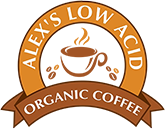If you are like most coffee lovers, you drink coffee for reasons such as a comforting ritual, satisfying experience, and how it makes you feel. It is true that coffee can be nutrient-rich and can offer physical and emotional health benefits, but there is a dark side to coffee. It turns out that many brands of coffee have mold and the toxins they produce, which are called mycotoxins.
Here is how they may affect your body and how you can avoid them while still enjoying your coffee daily. Spoiler alert: Alex’s Low-Acid Organic Coffee is tested to be free from mold and mycotoxins.
Background on Mold and Mycotoxins
We all know what mold is when we see it. It is the green stuff on cheese, or the white stuff on vegetables that have been sitting around for too long. We know that mold is “bad” intuitively, but do you know what the problem is?
Molds are types of fungi, just like mushrooms are fungi. They reproduce by letting their spores spread around, which is why they can grow so quickly across your stored fruits, vegetables, and yogurt. But they are not just ugly. Molds can be harmful.
Mold can produce chemicals called mycotoxins. “Myco” is just a word that means “fungus,” and “toxin” refers to something that is poisonous. These mycotoxins are most likely to be produced when crops, such as peanuts, grains, or coffee, are stored improperly or for too long. Being under these conditions lets molds grow and eventually produce their mycotoxins.
These mycotoxins really can be toxic. Having too much at once can make you ill. There are some people who may have a lower tolerance for mycotoxins and get sick faster or with a lower amount of exposure. You may even be allergic to molds. People may experience vague periods of confusion, such as “brain fog,” or may feel ill or have stomach discomfort.
Having exposure to mycotoxins over long periods of time - such as drinking contaminated coffee on a regular basis for years - can be linked to chronic health conditions. Still, it is hard to make these links, since people have many exposures to many possible chemicals over the course of so many years.
Liver and kidney disease are often looked at when thinking about effects of chronic exposure to mycotoxins. Some mycotoxins are also considered carcinogenic. Not surprisingly, many countries have strict standards for the amounts of mycotoxins that can be present in certain foods when they are sold to consumers.
Mold and Mycotoxins in Coffee
It turns out that molds aren’t just in fresh foods the way you may imagine. And mold is not always the result of being on a store shelf or in your kitchen for too long. Instead, mold is often in coffee beans. Mycotoxins called aflatoxin B1 and ochratoxin A are some of the most common types of mycotoxins in coffee beans.
Coffee beans from all over the world have been found to have mold and mycotoxins in them when they are sold to consumers like you. As many as 9 in 10 brands may have mold or mycotoxins, though some estimates are lower.
It seems as though green coffee beans are more likely to have high levels of mycotoxins in them. It also appears that roasting coffee beans can lower their levels of mycotoxins. Alex’s Low-Acid Organic Coffee is roasted to a medium dark or dark roast, depending on which variety you purchase.
Organic Coffee and Mold
Can you just purchase organic coffee and assume that it is free from mold and mycotoxins? Unfortunately, that is not a fair assumption. Organically grown coffee beans are cleaner than conventionally grown coffee beans in the sense that they are not produced with synthetic chemicals, such as potentially harmful pesticides and fungicides.
However, mold and mycotoxins are related more to processing and storage than to growing methods. Still, you can have both pure coffee and mold-free coffee. Alex’s Low-Acid Organic Coffee is an example of a coffee that is produced cleanly because it is organic, and is also free from mold.
How to Drink Mold-Free Coffee
So can you ever be certain that your coffee does not have mold in it? Luckily, the increased awareness of this issue is making it more possible to find clean coffee and let you experience the health benefits you expect and deserve from this naturally antioxidant-rich beverage. There are ways to test coffee to see if it is free from mold and mycotoxins, and ways to process and transport it to keep it free from harmful substances. Alex’s Low-Acid Organic Coffee does all of these to protect your health and well-being.
The best way to find a mold-free coffee is to look for one that is tested to be free from mold and mycotoxins. Alex’s Low-Acid Organic Coffee is independently tested and found to be free from mold and mycotoxins. That way, you can be certain that each time you brew a cup of Alex’s Low-Acid Organic Coffee, your coffee is completely pure and clean.
Once you purchase a coffee that you know is free from mold and mycotoxins, such as Alex’s Low-Acid Organic Coffee, you can do your part to keep it clean and prevent mold from growing. Store it in a cool, dark place in your kitchen and try to avoid exposing it to warmth and humidity for long periods of time to discourage the growth of mold.
You certainly do not want to expose your body to mold and mycotoxins, especially if you drink coffee for its benefits. But if you are drinking coffee regularly, you may be doing so unless you choose a coffee that is guaranteed free from them. Alex’s Low-Acid Organic Coffee is tested to be free from mold and mycotoxins, so you can feel good about what you are putting in your body on a daily basis or more often. Give Alex’s Low-Acid Organic Coffee and see how good a mold-free coffee can taste!

